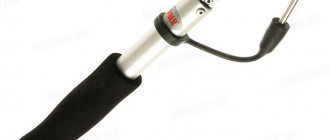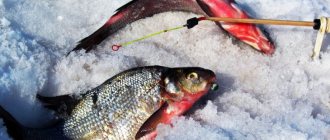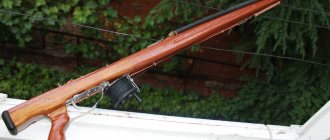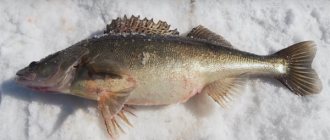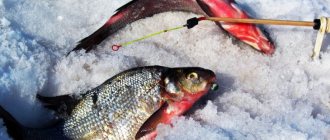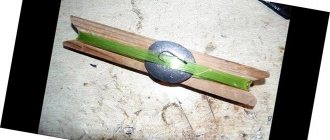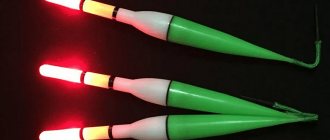The “crossbow” nod refers to non-standard products for winter fishing, which is of great interest to anglers.
The nod is intended for catching mainly bream and bream from the bottom of the reservoir with a winter fishing rod. Thanks to its design, it allows the fish to take and drag the bait without resistance, because the weight of the jig is compensated by the rotational energy of the nod due to the twisted rubber. The “crossbow” nod is in a state of equilibrium, and any fish manipulation of the bait does not cause resistance until the nod is out of balance.
Making a nod with a rubber shock absorber
Materials and tools
First, from a piece of fairly stiff wire we make the base of the crossbow according to the approximate dimensions as in the picture.
Crossbow wire base
We attach the wire frame to the whip using a heat-shrinkable tube, so that there is an interval of 5-10 mm from the end of the whip to the arc of the crossbow.
Frame on a whip
To the place where the frame is attached and to the tip of the whip, we glue pieces of small cambric to pass the fishing line using waterproof glue based on cyanoacrylate.
Cambrics
We fold the elastic band in half and tie the ends together; the piece should be such a length that when putting it on the frame, it needs to be slightly (!) pulled.
We thread the elastic loop into a transparent silicone tube (I used the one included in the set with Chinese fireflies), it should be transparent for ease of further installation.
Rubber in a tube
We take a rigid light plate and glue a cambric to one of its ends to pass the fishing line. The plate should not bend under the weight of the jigs being used. I made it from a piece of an old fiberglass fishing rod.
We insert the resulting guard into the pre-made holes in the silicone tube so that it ends up between the veins of the gum. It turned out like a crossbow arrow.
Boom assembly
We attach the arrow with rubber bands to the shoulders of the wire frame. The crossbow is ready.
Crossbow for winter fishing rod assembled
We insert the structure into the prepared fishing rod and reel. We pass the fishing line through the throughput cambrics and hang a control weight. The tackle is adjusted by twisting the ends of the rubber band so that the crossbow arrow takes a horizontal position (while fishing you will still have to make slight adjustments due to the density of the water and the weight of the jig with the attachment).
Alternative options
Shcherbakov's side nod
The same principle of balance is used in Shcherbakov's side nod. This nod is also very sensitive, easier to set up than a crossbow, but more difficult to manufacture.
- A small bearing is placed in tension at the end of the whip. For reliability, the bearing installation location is coated with waterproof glue.
- An iron rod - a rocker arm - is soldered to the top of the bearing perpendicular to the whip.
- On the longer arm of the rocker there is an eyelet for pulling the fishing line.
- A weight is placed on the other shorter arm of the rocker arm.
Balance is achieved by moving the weight along the short arm of the rocker arm or by putting on additional weights.
When grabbing the bait, the fish also does not feel any resistance; the tip of the nod reacts to the slightest bite.
Equilibrium platforms
This method of achieving balance does not require any additional equipment to be installed on the fishing rod.
- Two wooden rectangular narrow platforms are located one above the other.
- On the lower platform there is a wooden triangular post with a semicircular top fixed in the middle.
- In the center of the semicircular top, recesses were drilled with a drill.
- Along the edges of the upper platform in the middle, nails with bitten off heads are symmetrically driven in, bent at some distance at 900 degrees towards each other.
- The curved pieces of the top platform nails are inserted into the triangular post holes on the bottom platform.
- The platforms are balanced by moving a regular winter fishing rod forward or backward.
Due to the semicircular apex of the triangle, the platforms will still be in a state of equilibrium with a small impact.
The fishing rod is not attached to the platform and rests freely on the horns of the upper platform. When biting, the platform sways or is thrown out of balance. A swaying or falling down of the front or back of the upper platform signals a bite.
The horns are inserted into the holes of the upper platform; if necessary, they can be rearranged or completely removed, since the balalaika can simply be placed on the upper platform.
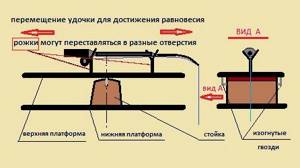
The design is unpretentious, but quite sensitive. It is better to use it in a tent or in calm weather.
Visualization of the nod of the bite on the rise and fall
Bite on the rise
Even a light bite on the rise will look very obvious, thanks to the elasticity of the elastic band. It should be noted that the arrow will not go down on its own, and therefore it will be possible to see the missed bite.
Lowering bite
When you bite down, the arrow will lower...
Example of a smooth running reel
The reel for a fishing rod with a crossbow for winter fishing should be such that the line comes out of it smoothly, without a locking mechanism, otherwise the tackle will be difficult to adjust. Nod - the homemade product is adjusted so that when installed above the hole, the jig with bait touches the bottom.
All the gear is presented in all its glory in the following photographs.
Minus the nod
The jig will not be able to move under the fast shaking of the perch , since sharp vibrations are compensated by stretching of the rubber and turn into soft and smooth ones.
This is the main disadvantage of a fishing crossbow - it can only provide soft, smooth vibrations of the jig.
Universalization of the nod
The only disadvantage of a winter fishing rod with a “crossbow” is its narrow specialization. Having installed the “crossbow” nod, it would be a pity to dismantle it, and it is not possible to implement with it the high-frequency, low-amplitude game that perches love. Should I remount the equipment every time? Should I take another fishing rod with me? This is not always convenient.
This problem can be solved simply.
At the end of the whip, a line pass ring is usually installed on top. Instead of the ring, you should install a soft silicone thick-walled hose (just carefully wrapped with electrical tape) with an internal diameter 10% smaller than the wide part of the nod.
When fishing with a crossbow, this hose can be used to pull the fishing line.
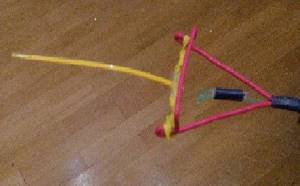
In another version, the nod is inserted with little force into the hose. The hose will take on an oval shape, tightly covering the nod. There will be enough space at the top to pull the line through.
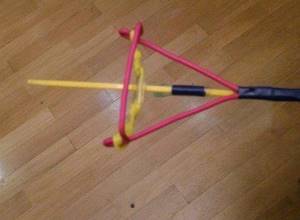
The rubber on which the nod rests does not interfere in this case, but rather adds additional color to the game.
Pros and cons of gear
Advantages of a crossbow:
- excellent sensitivity of the gear;
- good display of the most careful bite;
- adjustment for any bait weight;
- the fish does not feel the weight of the jig, the nozzle or the resistance of the nod.
Flaws:
- play is only possible slowly and smoothly; with sharp and frequent play, the guard lifts up;
- When lowering the bait quickly, the setting is lost; you need to lower it smoothly.
Polyakov Yuri Nikolaevich - Specially for the SamodelkiFish website, Nizhny Novgorod, Russia
- How to make a balancing nod on a rolling bearing with your own hands
- How to make a balancing nod on a plain bearing
Factors that determine a quality winter fishing rod
The tool for fishing in winter is significantly different from that used in the summer. The fishing rod is no exception; it is much smaller in size and equipped with a special nod. The latter is an analogue of a float and provides timely signaling indicating a bite. The nod is attached to the whip: for good contact you can use a clamp, electrical tape or a piece of strong wire.
It is noteworthy that a fishing rod made at home is not inferior, and often superior, to the serial models presented in specialized stores. It's all about little tricks that are used by professional fishermen who have been engaged in this type of activity for many years.
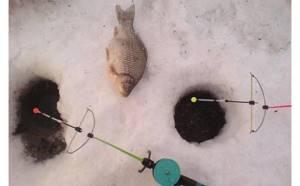
One of these devices is the so-called crossbow, which is excellent for catching bream and other fish with a careful biting style. Essentially, this is the same fishing rod, which is equipped with a special rubber shock absorber. It should be noted that the idea of such a tool appeared quite a long time ago, around the 1970s. Not all fishermen use it, but those who have tried this fishing rod in action do not regret the time spent on its manufacture.
|
A do-it-yourself winter nod crossbow will have a frame made of stainless wire, the diameter of which is 0.9 mm. The length of each arm is 5 cm, and the total width of the device is 7 cm. The sensitivity of the design is provided by an elastic band that is put on the shoulders and twisted. The heavier the weight of the weight, the stronger the twist should be and vice versa.
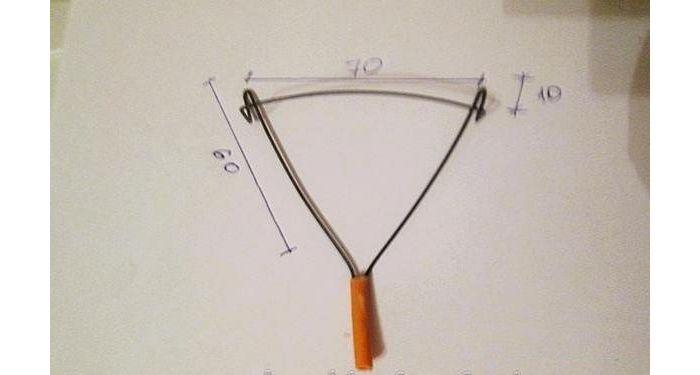
With the help of such a “crossbow” you can go fishing using just one tackle, but with different baits. Fishing methods are also very extensive: to maximum depth with a gradual rise, slow lowering, playing. This tackle is suitable for sop, silver bream, roach, crucian carp and other fish that do not require too active play, but need weightless bait.
Fishing technique
As already noted, winter crossbow fishing is stationary fishing for bream and crucian carp, as well as large roach from the bottom in winter or summer from a boat vertically. The equipment with the nozzle is lowered into the hole, the guard is installed in the working position. Naturally, the crossbow itself must be clearly adjusted to the weight of this equipment - otherwise it simply will not work. With a careful bite, the nod arrow rises and trembles in a certain middle position. When the nod rises, stops and does not fall, the bait is in the mouth of the fish, you need to hook it. The rubber shock absorber tends to raise the guard to its maximum point. If the fish throws the bait in the process, the arrow will jump to the top position (the opposite if there is no limiter in the design). Tactically, crossbow fishing in winter is no different from standard stand-up ice fishing. If it does not take the riser, it is recommended to sometimes carefully lift the bait from the bottom and tap it on the bottom to play with it.
This is interesting: How to distinguish a toadstool from an edible mushroom: signs of poisonous mushrooms
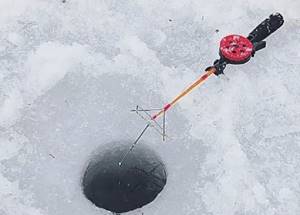
How to make a crossbow with your own hands?
You can make a crossbow with your own hands, but this may require materials and tools, which will be discussed below.
List of materials
To make it you will need:
- Fishing plates:
- Wire that will not rust over time;
- Glue that will be resistant to water;
- Whip;
- Plastic tube;
- Heat shrink tube;
- Rubber.
To assemble the entire mechanism you should take:
- A stationery or regular knife that is sharpened;
- Pliers – designed for clamping and gripping parts with various shapes;
- Scissors;
- Ruler for making accurate measurements;
- Matches.
Let's celebrate! The assembly procedure will not take a lot of time if everything is done evenly and all size rules are followed.
Manufacturing should be divided into stages:
- Provide a frame that should be used as a basis. To do this you should prepare:
- Base – 20 centimeters;
- Side parts – 6 centimeters;
- The horizontal part is 1 centimeter.
- Using a tube, attach the frame to a whip, leaving 5-7 millimeters at the edges, secure it to the frame with glue;
- The elastic band is rolled into a ring;
- The rigid plate is attached to the cambric;
- Using a tube, an arrow in a bow is imitated and fixed to the base;
- A fishing line with weights is pulled through the cambric.
For positive fishing, the crossbow should be adjusted using an elastic band. The fishing line must be held neatly and smoothly, and not be in one position under tension.
Reviews from fishermen about fishing with a crossbow
I have been a fisherman for almost 28 years, this is my outlet, although I don’t like to eat fish. I try to make all new items and devices with my own hands, and this is what happened with the crossbow. I made this device in 2 hours, 1 of which only took the preparation of materials and careful measurements. I can’t say that I succeeded the first time; I even wanted to break the device a couple of times because of its ineffectiveness, but then luck smiled at me. The time spent on the device was justified.
Grade:
Mikhail Afanasyevich, 48 years old
An infrequent fishing visitor is about me. I received a crossbow as a gift from a fisherman and didn’t even know how to use it. I literally learned it in 4 throws. The device is certainly good, but I didn’t pay a lot of money for it unless I made it myself. Grade:
Anatoly, 29 years old
I’ve been using my homemade one for 5 years now and it hasn’t let me down yet. I got so used to it that without it fishing wouldn’t be fishing. Grade:
Denis Pavlovich, 36 years old
I spotted such a device from a neighbor and decided to make it myself. It took me a couple of hours, but I finally assembled it; I’ll try it on the weekend. Grade:
Oleg Sergeevich, 59 years old
I’ve had a crossbow for 6 years now, although it was purchased. If it breaks without a second thought, I’ll buy a new one, a decent device. Grade:
Sergei Ivanovich, 63 years old
Let's celebrate! For some, a device that you need to assemble yourself will seem complicated and ineffective, but this is only because the skill to fish with such a device has not developed. It is necessary to give time to get used to and improve your skills as a qualified fisherman. In any case, the correct use of a crossbow, based on reviews, increases the catch of large fish.
Modification for onboard fishing rods broken tip
A variety of this equipment requires:
- Bend the ears down, as in summer the amplitude of the hook increases. If you leave your shoulders facing up, the nod may rip out when used on an onboard rod for fishing for bream from a boat.
- Mounts on a silicone cambric limiter, which will protect the nod from impacts.
- We insert an elastic band for donks into the cambric (5 cm when folded) and secure it with caps that will help us rotate the elastic band.
This modification allows you to fish from a boat at great depths, placing bait weighing 10 g or more. The standard crossbow nod cannot cope with such weight.
Design and adjustment to the weight of the equipment
There is no single design for a crossbow winter fishing rod - there are many design options, but they are all made on the basis of a single principle. The base is a rubber shock absorber, twisted in the opposite direction from the hole (to raise the nod, not lower it). The harness is attached to the horns of the wire frame. An arrow is inserted into the twist in various ways. The simplest thing is into the slot of the cambric placed on the flagellum. The arrow itself is often an ordinary lavsan or metal nod, but hard thin blanks (for example, carbon) can also be used. It's just a lever.
The twist tends to turn around, raising the guard accordingly. This force is limited by the load on the gear. The correct setting is the selection of the twisting speed. The more revolutions, the more the twist raises the needle. The greater the mass of equipment required to balance the system.
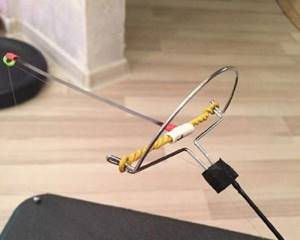
Settings
To set up the crossbow fishing winter tackle, remove the shock absorber from one horn and turn it around, putting it in place. We do the same on the other side. To increase elasticity, twist it towards the rod; to decrease it, on the contrary, release it. The frame itself on which the elastic band is attached can be of various shapes, made of plastic or metal. It’s good if the design provides a limiter - then in the maximum upper position the arrow rests against it. If there is no such limiter, then the guard in the upper position will bend in the opposite direction by 180 degrees and lie on the fishing rod, which is inconvenient.
There are many designs of such nods. They differ in the manufacture of elements - the frame itself, the method of attaching the elastic band. In the most sophisticated models, the elastic band is not simply attached to the horns of the frame, but is hinged through special caps that can rotate. Thanks to this, you can adjust the elastic band by simply twisting these caps without removing them from the horns. This setting is subtler - you can tighten the cap to any value, and after removing it the minimum step is one turn.
In the process of adjusting the elastic, we ensure that the equipment in the water barely keeps the nod from lifting. To install it in the working position, when almost all of the equipment is already lowered into the water, we smoothly lower the tackle to the bottom. The nod should remain in a horizontal position (or slightly tilt towards the water). You should not make sudden movements - otherwise the arrow will rise. Excess line is removed (given away) by the reel.
Video of making and setting up a crossbow nod with your own hands:
